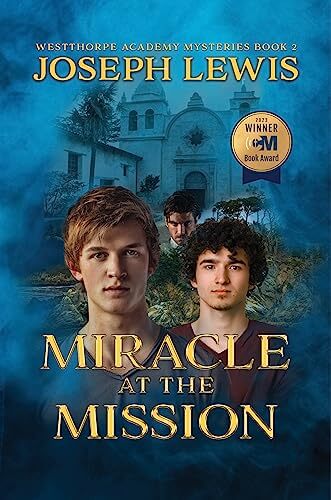Genre
Audience
Author’s Worldview
Catholic
Year Published
2022
Themes
Reviewed by
Dr. Lisa Theus
Russian assassins, international conspiracies, car chases, visions of St. Junipero Serra – what else will Joe Pryce and Pete Figueroa face on their summer trip to California? It all starts innocently when Pete is awarded second place in a national essay content hosted by Serra International, named in honor of St. Junipero Serra. He and Joe are invited to attend a conference for the organization in California over the summer. Excited for the chance to see the historic missions for themselves, they head to California intending to enjoy the history, relax in the state parks, and maybe get in a little search for gold. But little do they know that the President also will be in the area, attending the international G7 summit. He, too, is planning on visiting a mission – but rogue Russian operatives have their own plans. When these two paths cross, will it be too much for the boys to handle? Or will the mysterious friar who happens to look a lot like St. Junipero Serra be able to help them save the president?
On the surface, this book is an engaging action-adventure suspense novel, aimed at young men and enjoyable by anyone. But the themes cut much more deeply and are timely to the present (2020s). Joseph Lewis wisely sets the book in a vague, just slightly future time—in which Putin is no longer in charge of Russia, and the Catholic President remains unnamed. The leaders are fictional actors in an all too real situation, allowing the author and the reader to consider the issues of international relations, peace, and faith in a setting that is authentic without making political statements about actual leaders. What role can history play in understanding our current political situation? What are the parallels between the early settlements in California and today’s tense international relationships? How does faith influence our choices? These are the questions at the heart of Miracle at the Mission. The characters are all believable and interesting, despite the wild assassination plot, and even though it is the second in the series, you don’t need to read the first one to enjoy this. The events of the first book are discussed briefly to catch new readers up, and I didn’t have any trouble reading this on its own.
Two major current issues are tackled head-on in Miracle at the Mission: the attack by certain political groups on St. Junipero Serra as an oppressor and Russian-American relations. You can tell this book was written by a historian, as the first issue is discussed mostly through the setting of a conference, looking at the historical evidence and the traditions of the different peoples who live in northern California. On the other hand, the Russian-American political tension is overcome by a fervent belief in prayer and faith. To achieve peace, we must work for it – and pray, always pray. Although we won’t likely encounter miracles as notable as in the book, the reader still finishes feeling inspired to rely on faith and prayer.
Between the defense of St. Junipero Serra and the profound role of prayer, this book is ideal for Catholic readers. People who are hostile to the faith are likely to be unconvinced or—worse—downright angry at the defense of the saint who, in their view, was a villain. Protestant readers could go either way – it’s a fun, clean, exciting book that praises cooperation between peoples as witnessed in the history of different groups in California and the aftermath of the assassination attempt. Your attitude towards missionary priests will likely dictate how you feel about the beginning of the book. For me, as a lover of history, it hit the right notes. I was inspired by the faith of all the characters in the face of crazy circumstances, and I feel like I learned a lot about California and St. Junipero Serra. Altogether, it’s a fun read I’m happy to recommend to anyone who wants an almost unbelievable adventure.



